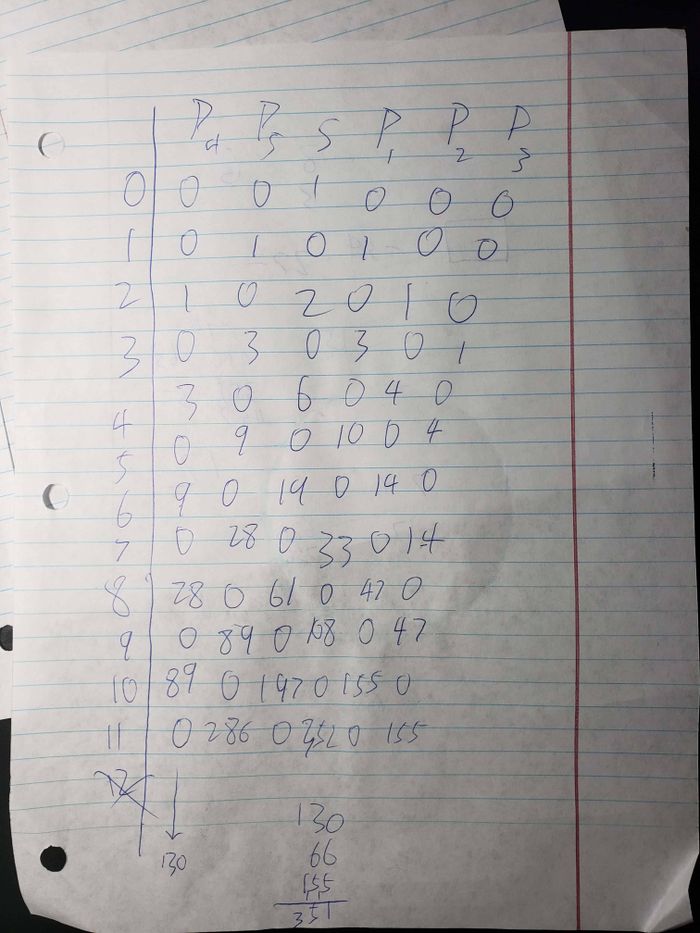Difference between revisions of "2018 AIME I Problems/Problem 14"
(→Solution) |
(→Solution) |
||
| Line 41: | Line 41: | ||
(Solution by scrabbler94) | (Solution by scrabbler94) | ||
| + | |||
| + | |||
| + | == Solution 2 == | ||
==Video Solution== | ==Video Solution== | ||
Revision as of 20:39, 8 January 2020
Problem
Let ![]() be a heptagon. A frog starts jumping at vertex
be a heptagon. A frog starts jumping at vertex ![]() . From any vertex of the heptagon except
. From any vertex of the heptagon except ![]() , the frog may jump to either of the two adjacent vertices. When it reaches vertex
, the frog may jump to either of the two adjacent vertices. When it reaches vertex ![]() , the frog stops and stays there. Find the number of distinct sequences of jumps of no more than
, the frog stops and stays there. Find the number of distinct sequences of jumps of no more than ![]() jumps that end at
jumps that end at ![]() .
.
Solution
This is easily solved by recursion/dynamic programming. To simplify the problem somewhat, let us imagine the seven vertices on a line ![]() . We can count the number of left/right (L/R) paths of length
. We can count the number of left/right (L/R) paths of length ![]() that start at
that start at ![]() and end at either
and end at either ![]() or
or ![]() .
.
We can visualize the paths using the common grid counting method by starting at the origin ![]() , so that a right (R) move corresponds to moving 1 in the positive
, so that a right (R) move corresponds to moving 1 in the positive ![]() direction, and a left (L) move corresponds to moving 1 in the positive
direction, and a left (L) move corresponds to moving 1 in the positive ![]() direction. Because we don't want to move more than 2 units left or more than 3 units right, our path must not cross the lines
direction. Because we don't want to move more than 2 units left or more than 3 units right, our path must not cross the lines ![]() or
or ![]() . Letting
. Letting ![]() be the number of such paths from
be the number of such paths from ![]() to
to ![]() under these constraints, we have the following base cases:
under these constraints, we have the following base cases:

and recursive step
![]() for
for ![]() .
.
The filled in grid will look something like this, where the lower-left ![]() corresponds to the origin:
corresponds to the origin:

The bolded numbers on the top diagonal represent the number of paths from ![]() to
to ![]() in 2, 4, 6, 8, 10 moves, and the numbers on the bottom diagonal represent the number of paths from
in 2, 4, 6, 8, 10 moves, and the numbers on the bottom diagonal represent the number of paths from ![]() to
to ![]() in 3, 5, 7, 9, 11 moves. We don't care about the blank entries or entries above the line
in 3, 5, 7, 9, 11 moves. We don't care about the blank entries or entries above the line ![]() . The total number of ways is
. The total number of ways is ![]() .
.
(Solution by scrabbler94)
Solution 2
Video Solution
https://www.youtube.com/watch?v=uWNExJc3hok
One page solution
| 2018 AIME I (Problems • Answer Key • Resources) | ||
| Preceded by Problem 13 |
Followed by Problem 15 | |
| 1 • 2 • 3 • 4 • 5 • 6 • 7 • 8 • 9 • 10 • 11 • 12 • 13 • 14 • 15 | ||
| All AIME Problems and Solutions | ||
The problems on this page are copyrighted by the Mathematical Association of America's American Mathematics Competitions. 
Video Solution
To see a comprehensive video covering this, visit : https://www.youtube.com/watch?v=uWNExJc3hok










